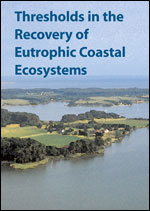By Jack Greer
Is the Chesapeake Bay stuck in an ecological rut? If we can reduce the input of nutrients, will the Bay and its rivers cross certain thresholds for recovery that will jumpstart self-healing? Can we find those thresholds and aim our efforts toward getting there?
According to researchers like Michael Kemp at the University of Maryland Center for Environmental Science, there is good reason to think that such thresholds exist, because we've almost certainly crossed them before. In particular, following centuries of deforestation, an increase in human wastes and farm fertilizers, and one very bad storm named Agnes in 1972, the Bay apparently slipped over a threshold into a new state where it remains today. Symptoms of that degraded state include catastrophic loss of underwater vegetation and an explosion of algae production that leads to oxygen loss in the Bay's bottom waters.
To help wrestle with these questions, Kemp organized a conference on thresholds, sponsored by the Chesapeake Bay Program's Scientific and Technical Advisory Committee (STAC) and the Maryland Sea Grant Program. Researchers came to Maryland in early 2007 from as far away as Denmark and Sweden to discuss what the public might call the Bay's tipping points.
Joining them were managers like the Executive Director of the Chesapeake Bay Commission, Ann Pesiri Swanson. Swanson spoke for elected officials and decision makers when she said that we have to be able to ask research questions in a way that makes clear which efforts are likely to trigger a recovery response. We have to ask questions, she said, that will help us target limited resources to make the most effective changes.
This conference on thresholds set out to frame those questions.
A number of case studies from the Chesapeake Bay, Pamlico Sound, Europe, and elsewhere demonstrated the complexity of the problem. Some rivers in these systems improved after nutrient reductions — and some did not. Or they responded in some areas but not in others. Take the Patuxent, for example. Reductions of nutrients upstream led to some improved conditions in the middle portions of the river, according to Kemp. Fewer algae blooms appeared. More native grasses came back. Downstream, though, near the river mouth, was a different story. Water quality did not improve.
In the lower Patuxent tides apparently bring in over-fertilized water from the Bay itself, say Kemp and other researchers. The influx of nutrients from the Bay seems to overwhelm reduction efforts of those living on the river. Instead of the river polluting the Bay, it seems that the Bay is polluting the river. At least that's what preliminary research suggests.
In other regions, researchers have learned other lessons. In the Neuse River, for example, work by Hans Paerl at the University of North Carolina suggests that focusing nutrient-reduction efforts on phosphorus alone can cause problems. In the Neuse, a tributary of Pamlico Sound, such efforts led to a decrease in algal growth upstream, but left nitrogen free to flow downstream, where it caused even more massive blooms and oxygen dead zones.
The lesson here: reduce both phosphorus and nitrogen.

|
Identifying when or where future thresholds might be crossed will require a close look at the past. That's where the clues to the future will be, researchers say. They called for taking "the long view" to better understand the dynamics of thresholds in the Bay. In particular they called for making better use of historical datasets — treasure troves of information that remain underappreciated and underutilized.
To gauge whether we're moving in the right direction, the group called for a close connection between monitoring and modeling and a close accounting for future impacts of climate change.
Further work should show how nutrient reduction efforts push natural systems like the Bay toward a particular threshold. When, for example, reductions in nitrogen input, on the one hand, and the increases of buffers like wetlands and underwater grasses, on the other, will tilt the Bay away from its downward spiral and toward ecosystem recovery.
A report from the thresholds conference is forthcoming from STAC and Maryland Sea Grant. For further details, contact Melissa Fagan (faganm@si.edu) at the Chesapeake Research Consortium or Erica Goldman (goldman@mdsg.umd.edu) at Maryland Sea Grant.
![[Maryland Sea Grant]](/GIFs/h_footer_mdsg.gif)